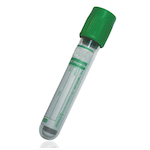Suitable Specimen Types
- Li Hep Plasma
- Dry Blood Spot
Sample Processing in Laboratory
Store separated plasma frozen, send frozen to referral laboratoryTurnaround Time
30 daysTyrosinaemia Screen (Succinyl Acetone)
General Information
Tyrosinemia type 1 is a genetic disorder characterized by elevated blood levels of the amino acid tyrosine. The condition is caused by a deficiency in the enzyme fumaryl-acetoacetase in the phenylalanine/tyrosine metabolism pathway. There is an accumulation of toxic metabolites fumarylacetoacetate, succinylacetone and succinlyacetoacetate, which inhibit several other enzymes.
The acute presentation includes clinical features: severe liver failure, vomiting, bleeding, septicaemia, hypoglycaemia and renal tubulopathy (Fanconi syndrome).
Chronic cases can present with: hepatomegaly, cirrhosis, growth retardation, rickets, haemotoma, tubulopathy, neuropathy and neurological crises (due to porphyrins).
Long term complications include hepatocellular carcinoma and renal failure.
Treatment should be started as soon as the condition is diagnosed and includes a diet restricted in tyrosine and phenylalanine along with nitisinone (NTBC), a medication that blocks the second step in the tyrosine degradation pathway thereby preventing the build-up of toxic metabolites.
Quantitative succinyl acetone is used as a screening test for tyrosinaemia type I. This is more specific than qualitative PBG synthase inhibition test which was used historically.
Succinyl acetone measurement is indicated in:
- acute liver failure
- chronic liver disease
- hypoglycaemia
- rickets, tubulopathy
NB: Succinyl acetone is NOT indicated in prolonged jaundice with no liver dysfunction or cataracts. Tyrosinaemia screens and galactosaemia screen are no longer carried out on all requests for either test (from 1st Jan 2018).
Reference Range
<0.5 umol/L
Source of Reference Range
Reference laboratorySpecifications
- EQA Scheme?: No
